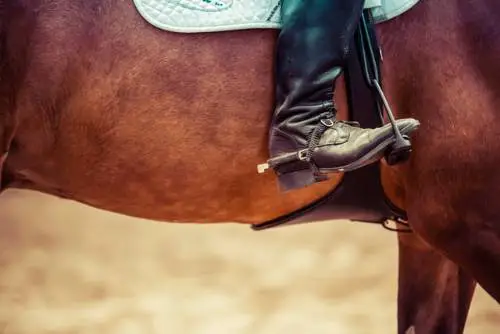
Horseback Riding in the Appalachians: Avoiding an Acrophobic Nightmare
Adventure Is Calling

Horseback trail riding in the Appalachian mountains is magical – spring, summer, fall or winter! But what if you don’t like heights?

Guide At a Glance
- Is this author an Adventurer?
- Is this Guide based on experience?
Your Next Quest
The Appalachian Mountain run from central Alabama up to Newfoundland, Canada; almost 2,000 miles (3,200 km) of mountainous forests, rivers, and meadowland running through multiple national parks. Within those parks are numerous opportunities for trail riding and exploring the Appalachians on horseback.
What you need to know before you go!
Trail riding is the real-world variety of exercise in the horse world, like the difference between running on a treadmill versus through a park to a human. To you (ideally as the rider), it poses a chance to explore the world, while either building or strengthening a teamworking bond with a truly majestic creature.
Trail riding requires a healthy level of physical aptitude and the ability to (dis)mount a horse, possibly frequently depending on the hazards on your chosen trail—anything from fallen logs to rivers. Beyond that, really anyone can ride a horse from children to adults, although a child with a fear of heights may have a harder time feeling comfortable on a horse. Any size of group can go horseback riding together, just leave one horse length between horses (its recommended that the most experienced riders take the front and back points).
Teach me your ways!
First thing is to make sure both you and your horse are ready for the trail, with you being properly dressed; the horse’s saddle and tack being well-secured.
- Tug right to go right; tug left to go left, tug back to reverse. Be gentle! Your horse knows the terrain better than you do.
- Give the horse his head on steep hills. Otherwise, he’ll be off-balance.
- Most horses like being brushed or scratched on the neck and withers.
- Wear jeans! One word: chafing …
- Keep one hand on the saddle horn for support.
- Don’t push up too hard in the stirrups. You’ll burn out your thighs.
- Lean back when riding down steep hills.
- Don’t forget to duck going under trees!
- Don’t walk behind a horse. You can get kicked and seriously hurt.
Once you’re on the horse, the fun has begun! You are ready to hit the trail to experience the Appalachians….
Need some inspiration?
Still undecided?
PROS
- Explore farther into the wilderness than you could on foot.
- Build a bond with an amazing, gentle giant.
- Learn and/or practice equestrian skills.
CONS
- You may have to help a 1,000+ lb creature figure out how to cross a fallen log.
- Fording water often involves leading the horse—in which case you will get wet.
- All the bugs still like you (and your horse)!
Inspire




Where and When to Go?
Biome
The Appalachian Mountains spread from Alabama to Canadian Newfoundland and Labrador, with many options for trail riding in national forests across several states. The good news for the acrophobics (fear of heights) among us is that, despite being a mountainous region, not every trail is along or headed to a cliff … unless you visit the North Carolina/Tennessee border region which features an inordinate number of high points!
Season
Fall is excellent for the beautiful autumn leaves, but summer outings—despite temperatures in the 90s—can be pleasantly cool in the forests. Even winter outings are possible, especially in the southern Appalachians.
Regions
Here are some recommended horse trails in the Appalachians, as well as nearby horse campgrounds.

Virginia
Virginia Highland Horse Trail (Fox Creek or Hussy Mountain Horse Camps) at George Washington & Jefferson National Forests.

North Carolina
Wash Creek Horse Camp at Pisgah National Forest (this one is further south, an interesting prospect for winter rides).

West Virginia
Mountain Trail Rides in Canaan Valley, West Virginia, a beautiful high-altitude Appalachian valley dotted with red spruce stands and mountain meadows.
Essential Outdoor Skills
What outdoor and survival skills should I master before embarking?
Horseback riding and navigation skills are critical if you are going on your own. Check out some of the tips I listed earlier, such as:
- How to handle the reins
- How to mount a horse from one side
If you are taking a guided tour, they will help you with everything you need to know!
Numbers to remember
Safety & Risk
Is this adventure for you?
Horseback riding is teamwork between you and your horse. Riding in the Appalachians is the same as anywhere else, in that your horse spooking and causing injury is a primary concern. Either throwing you off (potential head injuries) or putting you at risk from hefty horse limbs (if you are currently on the ground) are the most common injures and risks in horseback riding. Make sure you have a healthy hold on the reins, so the horse can’t take off running with you on top either!
Consider wearing a helmet. If you do get bucked, the fall is going to be a bit rougher than it would be in a paddock. Wear boots strong enough to protect against an errant horse hoof placed on top of your toes, with heels to keep your feet in the stirrups. Long pants that fit well can help protect against any brambles or low-hanging branches you pass on the trails.
Otherwise, check your gear to make sure it’s fit and in good condition before you get on the horse, including ensuring that the saddle is fitted for both you and the horse. These are all things that you’ll most likely have previous experience with or else the group you’re riding with will help you check off.
- Wear a helmet and jeans!
- Watch for the weather.
- Horses slip. Avoid deep mud and slick rocks!
DO'S
- Check your saddle fit.
- Wear fitted clothing that still lets you breathe easily.
- Consider protecting your skull from initial impact by wearing an exterior skull (aka helmet!)
DONT'S!
- Wear flipflops, you will lose them and riding barefoot is … problematic.
- Hang out gabbing by a horse’s rear end—not only is it weird, it’s also potentially dangerous,
- Use that antique tack you got for a bargain because it’s rusted and mouse-chewed. 1) ew! and 2) dangerous!
Wildlife
What animals can I expect to encounter?
Wild ponies & long-horned cattle, especially when you visit the Mount Rogers area in Virginia.
Overall, the wildlife you’ll see around the Appalachians may vary by area, but you can consistently find mammals, birds, and reptiles. From moose and deer to bears and smaller animals like chipmunks, rabbits, squirrels, raccoons, skunks, and porcupines, there are a variety of mammals in the mountains. Birdwatchers might want to keep an eye out for hawks, woodpeckers, thrushes, wrens, and grouses (along with more unique ones by area). Frogs, salamanders, and turtles can be found closer to water.
There are rattlesnakes in the Appalachians, which is one subtle but notable wildlife danger to both humans and horses. Rattlesnakes will only attack if surprised, but still be sure to keep your eye out. Rattlers are primarily in the southern area of the mountains, up through New York and Pennsylvania.



Fitness & Training
What is the recommended level of fitness?
You will require the limberness to clamber over obstacles on your own two legs as needed, as well as weight management to help ease your horse’s burden (so you’re not bumping along like a sac’ o’ potatoes).
If you are bringing your own horse, then they should be able to travel double the trail you are taking—worn-out horses can get upset on the way back or else require a post-ride lay-up, neither of which is fun for you or the horse!
Training and preparation exercise regimen
Start simple cardio exercises weeks in advance, enough to get a light sweat up. Three to four times a week will get you into a right fit state. Exercise your horse 3 times a week for at least 20 minutes to maintain their fitness.
Gear Guide
What gear do I need for this trip?
Required Gear
The primary gear for trail-riding are things that you will likely already have if you own a horse, or they will be provided if you’re joining a group. You will need the horse tack: halter, saddle, saddle pad, bridle & bit, along with grooming tools for your horse (hoof pick, curry comb, and soft brush). Grain or pelleted food & hay for horse feed are also necessary.
Supporting Gear
Beyond basic clothing, horseback riding also requires heeled boots (to help keep your feet in the stirrups); gloves, helmet, and chaps are all recommended for longer riding outings. A utility pail can be helpful to have around when traveling with horses, along with an animal first aid kit & hoof treatments as horses are just as prone as humans to acquiring a few bumps and scrapes along the way.
Accessories & Apps
Depending on the when and where of your visit, fly control might be a good idea if you’re bringing your own horse. Carrots are an excellent accessory to really show your horse some love! (In moderate doses, of course.)
Finances & Budget
What are the costs associated with this adventure?
Gear & Products
A good tack and grooming setup costs around $850. But good news! If you go with a guide, you won’t need to bring any of your own gear.
Food & Nutrition
A horse’s feed costs around $2.34 per day. For the humans in the group, the cost depends on how complicated your style of campsite cooking is. However, if you’re joining a horse-riding group, meals are sometimes included.
Transportation
It costs $0.75-$3 per mile for professional horse transportation, however that’s more typical for moving households. A horse-trailer costs around $5000 minimum. Trucks get about 4-10 mpg, pulling a trailer with one horse will drop that by 10-15% to around 3.4-8.5 mpg, which gives a baseline to calculate from depending on how far you need to drive!
Accommodations
Your cheapest accommodation when you are traveling with horses is a horse campground within the national parks. Of the ones mentioned above: Fox Creek costs $5 per vehicle nightly and Hussy Mountain is at $7 per vehicle nightly. Wash Creek is up at $30 per vehicle nightly, as it is possible to make reservations in advance there.
If you are visiting a ranch to join a group tour, there are two notable ones: Appalachian Horseback Riding Adventures in Grayson County, VI and Appalachian Trail Rides in Blue Ridge, Georgia. Neither provide housing on site but options for the areas around are between $81-125 for hotel rooms or Airbnbs per person.
Miscellaneous
Horses that cross most state lines are required to have a Coggins Test within the last year ($20-60)
You will also occasionally encounter day use fees depending on where you opt to ride.
Savings Tips
If you decide to visit Appalachian Trail Rides in Blue Ridge, Georgia, consider bringing some friends along! It is possible to rent a cabin for $120-500 per night for 4-6 people—which could drop the price per night to $40-83 per night per person.
Insider Tips
Insider Tips
- If you are riding your own horse, start adding electrolytes in small doses a week before departure so your horse has time to adjust to the change instead of a sudden large dose immediately before—which can ironically cause dehydration by pulling fluid out of the bloodstream.
- Have oatmeal for breakfast, this may even be the time to try that overnight oat recipe you’ve been eyeing on Pinterest. It’s quick to grab in the morning when you’d rather be hitting the trail and it will give a good amount of energy to keep going on the trail.
- Be mindful of crossing over with hunting territory during your ride. Due diligence and some dayglo orange gear could be very critical!


FAQ
Absolutely! Equestrian pursuits can be a great family activity, most guided tours will take families.
Not really! Anyone in moderate health can go horseback riding. Just be careful if you have existing joint problems, particularly in your knees or lower back.
You’re going to have to swing a wilderness approach to this, as you will mostly likely been out for several hours.
See Notes on transportation in the Finances & Budget section.
See notes in the “Where and When to Go?” section.
- Appalachian Horseback Riding Adventures in Grayson County, Virginia.
- Appalachian Trail Rides in Blue Ridge, Georgia.
- Mountain Trail Rides in Davis, West Virginia.


